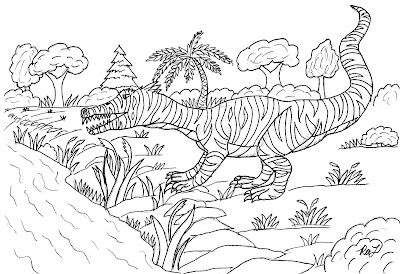Spinosaurus after a Sawfish
Spinosaurus aegyptiacus is the most well known Spinosaur. But there are a few others as well. I am posting drawings of three of them. All appear to have fed primarily on fish. They had jaws that were far weaker than Tyrannosaur jaws. In fact, I disagree with the scene in Jurassic Park III. I think that if a T. rex fought a Spinosaurus, and if they locked jaws, the T. rex would have ripped the Spinosaur's jaw off. This is because Spinosaurs had a jaw with muscles for caching fish. Their jaws were far weaker than a bone crushing Tyrannosaur's jaws. Even so, Spinosaurus was truly the biggest known Theropod or meat eating dinosaur. Spinosaurus was the biggest at a length between 55 and 60 feet. That is around 17-18 meters long. I guess one big advantage that Spinosaurus would have over a T. rex is that Spinosaurus had a pair of huge arms with a large claw on the inside finger. Some paleontologists have the thought that that huge claw was used to fillet fish. Spinosuarus caught and ate huge sawfish. They also ate big lungfish, Coelacanths (a large ancient fish) and river sharks. Spinosaurus lived in a river delta system. Some of the fish that lived in the river delta system were over 20 feet or 7 meters long. At least the sawfish could get that big. Ceolocants were around 6 or 7 feet or 2 meters or so long. It appears that all Spinosaurs lived in fertile river systems. The Spinosaurs probably only ate land animals when the fishing was bad. Spinosaurus lived on the opposite side of the early Atlantic Ocean and millions of years before T. rex evolved in North America. Spinosaurus lived 112-93.5 million years ago.
Suchomimus feeding her Young
Suchomimus was an earlier Spinosaur. It lived south of where Spinosaurus was found in Morroco and Egypt. Suchomimus had a sail, but it was a much shorter sail. Suchomimus may have been an ancestor to Spinosaurus. Suchomimus lived 125-112 million years ago. In any case, it appears that Spinosaurus may have replaced Suchomimus in the river delta ecosystem. Notice that Suchomimus had that large claw like Spinosaurus.
Baryonyx juvenile by a River
At 33 feet or 10 meters, Baryonyx was even smaller. . . although 33 feet long was NOT small. Baryonyx means "heavy claw". . . . so like all the later Spinosaurs, Baryonyx had the large index finger fish filleting claw. In fact, Baryonyx had it first. It lived 130 to 125 million years ago. This drawing is of an adolescent or juvennile by a river.
Now look at the end of the snout of each of these dinosaurs. They all had motion sensors, like crocodilians have... to sense motion in the water. This would allow them to fish or hunt in murky river water. Also notice that their nostrils are up high on the snout. This gave them the ability to stand on the bank, if they wished, and stick their snout in the water to sense and then catch fish.
NOTE: The Baryonyx and the Suchomimus were drawn with markings, stripes and spots. I did not add markings to the Spinosaurus, so you can add them as you color it if you wish. The three drawings above are all new drawings so they are found, in printable form, at the bottom of the list. To get to the correct list then click on the buttons up top. Click on . . . . . All Printables. . . . or . . . . . . . . . . . . . . . . . . . . . . . Paleontology. Then scroll down to the bottom for the three new drawings. I am also adding some older drawings of these three Spinosaurs below. I did them in the past. . . so they will be further up the lists of printable drawings.
Now look at the end of the snout of each of these dinosaurs. They all had motion sensors, like crocodilians have... to sense motion in the water. This would allow them to fish or hunt in murky river water. Also notice that their nostrils are up high on the snout. This gave them the ability to stand on the bank, if they wished, and stick their snout in the water to sense and then catch fish.
NOTE: The Baryonyx and the Suchomimus were drawn with markings, stripes and spots. I did not add markings to the Spinosaurus, so you can add them as you color it if you wish. The three drawings above are all new drawings so they are found, in printable form, at the bottom of the list. To get to the correct list then click on the buttons up top. Click on . . . . . All Printables. . . . or . . . . . . . . . . . . . . . . . . . . . . . Paleontology. Then scroll down to the bottom for the three new drawings. I am also adding some older drawings of these three Spinosaurs below. I did them in the past. . . so they will be further up the lists of printable drawings.
Spinosaurus Close Up
Suchomimus at Hatching Time
Baryonyx the Spinosaur
Spinosaurus with Spots
(This is actually the most accurate drawing of Spinosaurus aegyptiacus. It has shorter back legs. A new fossilized skeleton was discovered a few years ago in Morocco and it showed shorter legs than most Theropods. It appears that Spinosaurs lived much like a modern crocodile or alligator etc.)







No comments:
Post a Comment